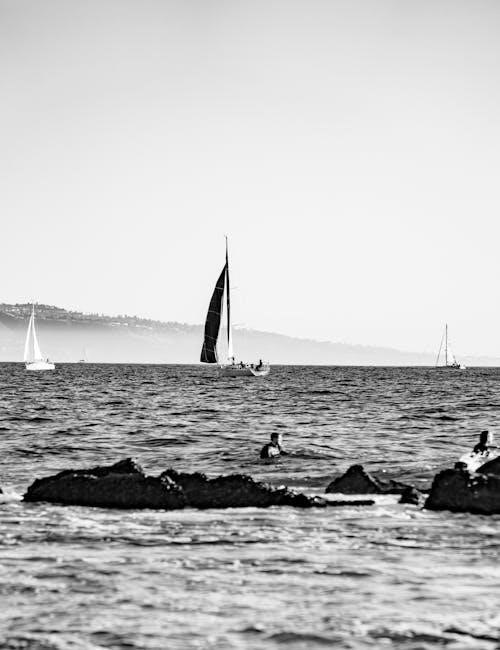Distance and displacement are fundamental concepts in physics, measuring motion. Distance is the total path length traveled, while displacement is the straight-line distance from start to end, considering direction. Understanding their differences is crucial for analyzing motion accurately.
1.1 Definition of Distance and Displacement
Distance is a scalar quantity representing the total length of the path taken by an object. It does not consider direction, so it is always positive. Displacement, on the other hand, is a vector quantity that measures the straight-line distance from the starting point to the endpoint, taking direction into account. Unlike distance, displacement can be zero if an object returns to its initial position, and it can be positive or negative depending on the chosen reference direction.
1.2 Importance of Understanding Distance and Displacement
Understanding distance and displacement is essential for analyzing motion accurately. Distance provides the total path length traveled, while displacement gives the direct change in position. This distinction is crucial in physics and engineering for calculating speed, velocity, and acceleration. For instance, in sports, knowing the distance covered helps assess performance, whereas displacement determines the net movement from start to finish. In transportation, route planning requires understanding both concepts to optimize paths and reduce travel time. Grasping these fundamentals enhances problem-solving skills and real-world applications in various fields, making them indispensable in both academic and practical scenarios.

Basic Concepts and Formulas
Distance is a scalar quantity representing total path length, while displacement is a vector showing straight-line distance with direction. The formula for displacement is final position minus initial position.
2.1 How to Calculate Distance
Distance is a scalar quantity representing the total length of the path traveled by an object. To calculate it, sum all individual segments of the path. For example, if someone walks 3 km north and then 2 km south, the total distance is 5 km. Use the formula:
Distance = Σ (individual distances). This method ensures accuracy by considering every part of the journey. Always measure in consistent units, such as meters or kilometers. Unlike displacement, distance does not account for direction, making it a straightforward metric for total movement. Practice worksheets often include scenarios like these to help master the concept effectively.
2.2 How to Calculate Displacement

Displacement is a vector quantity representing the straight-line distance from the starting point to the ending point, considering direction. To calculate it, use the formula:
Displacement = Final Position ─ Initial Position. For example, if an object starts at position 0 and ends at 5 meters, the displacement is +5 meters. If it moves back to 3 meters, the displacement is +3 meters. In two dimensions, break the motion into components (north-south and east-west) and use vector addition or the Pythagorean theorem. For instance, moving 3 km north and 4 km east results in a displacement of 5 km northeast. Always consider direction, with east and north typically positive. Use graphical methods or algebraic approaches to simplify complex paths. Unlike distance, displacement can be zero if the object returns to its starting point.

Sample Problems and Solutions
A girl cycles for 3 hours at 40 km/h. Distance: 120 km. Displacement: 120 km straight ahead.
Michelle walks 100m west, then 20m east. Distance: 120m. Displacement: 80m west. These examples clarify the difference between total path and straight-line change.

3.1 Word Problems Involving Distance and Displacement
Word problems involving distance and displacement test understanding of motion concepts. For example, if David walks 3 km north and returns 2 km south, his distance is 5 km, while his displacement is 1 km north. Another problem: A girl cycles 40 km east in 3 hours. Her distance is 40 km, and her displacement is also 40 km east. These problems highlight the difference between total path length and straight-line change. They often involve multiple directions or returns, requiring careful calculation. Solving such problems enhances analytical skills and clarifies the distinction between distance and displacement in real-world scenarios.
3.2 Graphical Representation of Paths
Graphical representation of paths is a visual method to understand distance and displacement. By plotting movements on grid paper, students can measure the total distance traveled and determine displacement. For example, if Stan walks 10 km west to a store and returns 8 km east, his path can be drawn on a grid. The distance is the total kilometers walked (18 km), while displacement is the straight-line distance from start to end (2 km east). This method helps visualize motion, making it easier to distinguish between distance and displacement. Such exercises are often included in worksheets to enhance spatial understanding and problem-solving skills.

Common Misconceptions

A common misconception is that distance and displacement are the same. However, distance refers to the total path length, while displacement is the straight-line distance from start to end, considering direction.
4.1 Difference Between Distance and Displacement
Distance and displacement are often confused but distinct. Distance is the total length of the path traveled by an object, regardless of direction. It is a scalar quantity, meaning it has no direction. Displacement, on the other hand, is the straight-line distance from the starting point to the ending point, taking into account direction. It is a vector quantity, having both magnitude and direction. For example, if someone walks 3 km north and then 3 km south, the total distance traveled is 6 km, but the displacement is zero because they end up where they started. This distinction is crucial in physics for accurately describing motion.

Worksheets with Answers
Reliable worksheets on distance and displacement are available online, offering varied problems. They include word problems, grid-based path plotting, and multiple-choice questions. Answers are provided for self-assessment and understanding.
5.1 Where to Find Reliable Worksheets
Reliable worksheets on distance and displacement can be found through online searches, educational websites, and platforms offering free PDF downloads. Google searches yield numerous resources, such as “Distance and Displacement Worksheet” by Savannah Montelongo, available as PDF or Word documents. Websites like Scribd and educational forums also provide access to these materials. Many worksheets include word problems, grid-based path plotting, and multiple-choice questions to cater to different learning styles. Some documents, like “Distance and Displacement Practice Solutions,” offer answers for self-assessment. These resources are ideal for students and educators seeking to practice and master the concepts of distance and displacement effectively.

5.2 How to Use Worksheets Effectively

To use distance and displacement worksheets effectively, start by understanding each problem’s requirements. Identify whether the question asks for distance or displacement. For distance, calculate the total path length, while for displacement, determine the straight-line distance from start to end. Use grid paper to plot paths accurately, ensuring measurements are precise. Check for understanding by comparing answers with provided solutions. Review mistakes to avoid repetition. Utilize word problems to apply concepts to real-life scenarios, enhancing problem-solving skills. Regular practice with these worksheets helps reinforce the distinction between distance and displacement, improving overall mastery of motion analysis.
Mastering distance and displacement requires practice and understanding their definitions. Regular use of worksheets with answers enhances problem-solving skills, ensuring accurate calculations and clear conceptual differentiation.
6.1 Final Tips for Mastering Distance and Displacement
To excel in understanding distance and displacement, consistently practice with worksheets. Start with basic problems, gradually tackling more complex scenarios. Plotting paths on graph paper helps visualize motion. Pay attention to direction, as it distinguishes displacement from distance. Reviewing formulas and definitions regularly reinforces concepts. Utilize answer keys to verify solutions and identify areas for improvement. Engage with real-world examples to apply theories practically. Time management during practice ensures thorough understanding. Collaborating with peers or tutors can clarify doubts and enhance learning. By following these strategies, mastering distance and displacement becomes achievable and rewarding.

